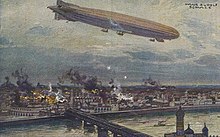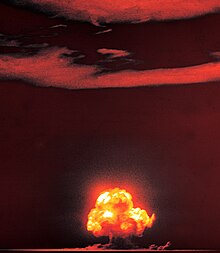Wikipedia:WikiProject Military history/News/June 2015/Op-ed
|
War Horse / Iron Horse |
By June 1915, the Central and Allied Powers engaged in the First World War had been forced to adopt and improvise tactics in response to new technology barely dreamed of by nations or armies twelve months prior. This month a century ago saw the first anniversary of the assassination of the Archduke Francis Ferdinand and his fiancée in Sarajevo, so it seems appropriate to reflect on the rising military–industrial complex, which had by this time begun to exert its pull on the course of the war.

It was at this point no secret that poisonous gas and other chemical warfare agents had begun to make their appearances on the Western Front of World War I. These weapons, which would create some of the most memorable if disturbing images and testimonies of the war, had been banned under international treaties in effect at the time, however the paper treaties had been disregarded by the Central Powers in their attempts to gain the upper hand on the Western Front against the Allies. The introduction of tear gas, and later chlorine gas, to the front lines resulted in a massive rush by Allied powers to equip forces bound for the Western Front with gas masks, to improve the survivability of the troops now at risk of a chemical warfare attack by enemy forces arrayed on the stalemated Western Front.
The Allied and Central Powers had also begun to flesh out early plans for aerial warfare, including the use of planes to reconnoiter and attack enemy forces. The armed forces of the German Empire had taken aerial warfare one step further, employing massive Zeppelins to execute strategic bombing raids against population centers, with the initial objective of destroying enemy military facilities en masse, although the Imperial German armed forces were pleasantly surprised to find that the bombing attacks had a high psychological warfare value. Efforts to neutralize this threat led to the creation of the first dedicated air defence forces, which up to this point in time had played a limited role for the army and navy, primarily surveillance and scouting. The weaponization of these aircraft from 1914 and 1915 had led to the creation of not only entirely new methods of attacking an enemy force, but had resulted in the creation of an entirely new theatre of war: the airborne theatre. Thus in the twelve months since the start of the war new aircraft attacks and anti-aircraft tactics began to make appearances in both sides respective military forces, and this legacy endures today with military doctrines that call for armed forces to gain and maintain air superiority or air supremacy in combat zones.

The naval forces of the Allied and Central powers began fighting each other with surface engagements intended to support invasion forces. In 1915, the Imperial German Navy began a campaign of unrestricted submarine warfare intended to intercept and destroy freighters working to keep European nations - and in particular the British Empire - from obtaining needed supplies to keep the war machines running. This would eventually put the German Empire at odds with many Allied nations, and would result in a shift in the political position of the United States in the aftermath of the loss of Lusitania in 1915. In the Asia-Pacific region, the Empire of Japan had begun to flex its military muscles by seizing German Empire-held colonies in the region with the blessing of the British Empire. Notably for military historians, in 1914 the Empire of Japan executed the world's first naval-launched air raids against German-held land targets in Shandong province and ships in Qiaozhou Bay from the Japanese seaplane carrier Wakamiya, foreshadowing the rise of the aircraft carrier as the principle striking arm of a nation's naval force. The Empire of Japan would subsequently declare war on the German Empire and later Austria-Hungary, and within the year would go on to occupy the Mariana Islands, Caroline Islands, and Marshall Islands, among other regions.
Historically, war has always breed innovation; in periods of conflict the human race tends to rapidly advance its technological and scientific boundaries to meet the demands placed upon the nations in question to defeat their enemies. By June 1915, both the Allies and Central Powers were beginning to see the full impact of this effect not only in the technology and strategies being introduced, but in the rapid obsolescence of some long standing military doctrines, strategies, and equipment. Most noticeably for nearly all sides at this point in the war was the apparent obsolescence of the war horse, long held to be a staple of military doctrine and tactics. Since ancient times military records have testified to the presence of horses on battlefields, ranging from scouting units to more modern cavalry forces that had been in use as late as the 1800s as a vital part of most nation's army.
On the Western Front of World War I alone, the horse was rather abruptly displaced from its position of honor as a result of machine guns being introduced on this front. Railroad forces had allowed for the rapid deployment of military forces close to front lines, reducing the risk of meeting engagements between enemy forces and allowing both sides to bring men and munitions to front in quantities that would have been unimaginable just a few decades earlier. Rail-mounted artillery units and mechanized weapons like the machine gun had begun to transform military tactics such that they had consolidated or eliminated the need for other such military units. While the machine-gun nests and aircraft had begun to displace cavalry and ground based reconnaissance units, the evolutionary effect of the weapons and tactics being introduced was such that forces were still struggling to learn, adopt, and employ them, therefore many units that were ostensibly no longer needed were retained by military forces on the field of battle for the needs of the state and for lack of proper understanding of how the evolution of the new fully effected the old and the currently in use. Stated more simply, the needs of the nations embroiled in war was such that even obsolete weapons and tactics were employed if it was thought that they would be of any use on the battle lines.
While the impact of the changes being brought about by the military–industrial complex was not lost on the participating nations, some of the greatest and most memorable weaponry had yet to make its debut, and some of the bloodiest battles of the war had yet to be fought. Undoubtedly though, one year into the war, many military commanders and heads of state must have wondered exactly how deep the Pandora's box they had opened in July of 1914 went, and how high the price in men, machines, and money would be for their hubris in thinking that such a massive conflict could be won so easily in the first major conflict of the industrialized age. Although not approaching the size or scope of the war then being fought in Europe, the United States had experienced the bitter taste of an industrialized conflict during its Civil War, and had come to understand what machines like the railroad locomotive and the armored steamboat could do in battle. Perhaps it was these still-recent memories that had compelled the US administration to cling so steadfastly to the declaration of neutrality issued at the start of World War I, for fear of what the next major industrialized war would look like, and the fear of the cost to paid by volunteering to fight on increasingly industrialized and mechanized battlefields.
|




